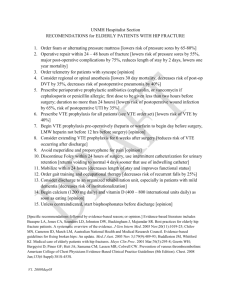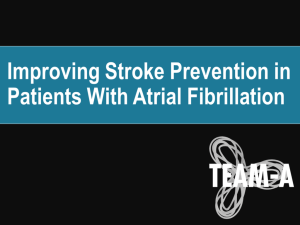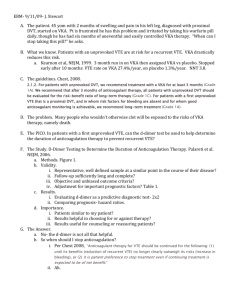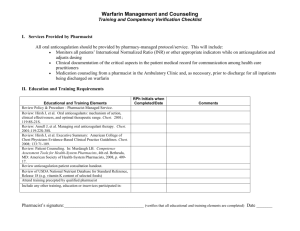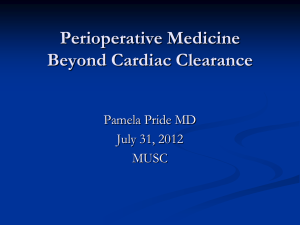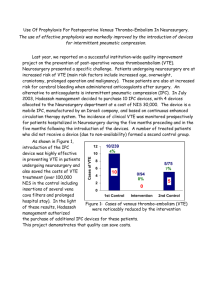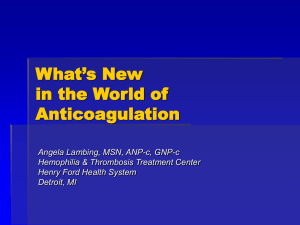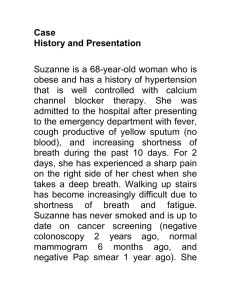TN Pharmacist Coalition Antithrombotic and Anticoagulation Gap
advertisement
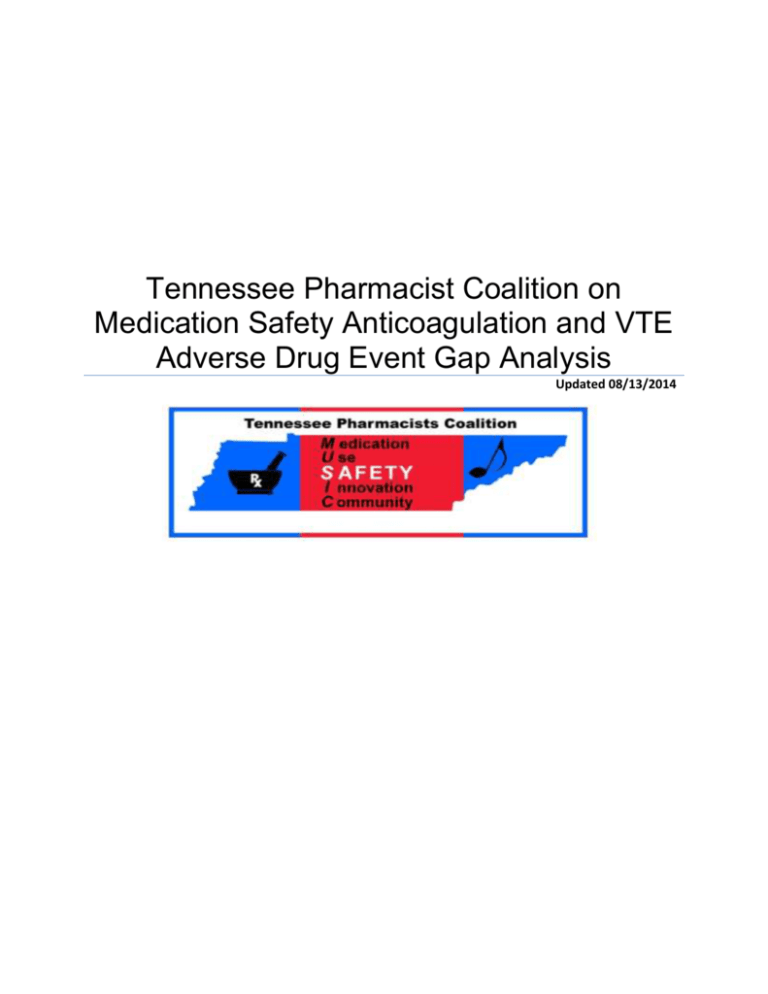
Tennessee Pharmacist Coalition on Medication Safety Anticoagulation and VTE Adverse Drug Event Gap Analysis Updated 08/13/2014 Tennessee Pharmacist Coalition on Medication Safety Anticoagulation and VTE Adverse Drug Event Gap Analysis Antithrombotic and Anticoagulation Management Practices Gap Analysis Questions Yes No If answered “No” – identify the Specific Action plan(s) including persons responsible and timeline to complete. 1a) The facility has assigned responsibility for coordinating antithrombotic and anticoagulation monitoring functions. 1b) The facility has a process in place to ensure fields contained in standard protocols/order sets/flow sheets are consistently populated (manually or automatically) with key information, including at a minimum: i. The patient’s diagnosis. ii. Allergies. iii. Most recent pertinent laboratory results. 1c) The facility has standard policies and practices in place for managing the initiation and maintenance of antithrombotic and anticoagulation therapy which include: i. The specific medication used (e.g., low molecular weigh heparin (LMWH), warfarin, unfractionated heparin (UFH), Vitamin K reversal, direct thrombin inhibitors, Factor X inhibitors, Factor containing products, platelets, desmopressin). ii. The condition being treated. iii. The potential for drug interactions. iv. The potential for patient specific interactions. v. The facility has a protocol in place to determine the need to reverse supra-therapeutic INR values based on key criteria (e.g., the INR value, the presence or absence of bleeding, individual patient situation, e.g., imminent surgery). vi. The facility has a process in place to ensure that anti-platelet agents are used for the appropriate indication (e.g., patients with mechanical valves, acute coronary syndrome, or recent stent or bypass surgery). 1d) The facility’s Vitamin K practice specifies in patients with no evidence of warfarin associated bleeding: i. No routine use of Vitamin K for INR between 4.5 and 10. ii. The use of oral Vitamin K for INR >10. 1e) In patients with warfarin associated major bleeding: i. Reversal may be accomplished with the addition of Vitamin K 5 -10 mg given by slow IV infusion. ii. Reversal may also be accomplished with prothrombin complex concentrate and the addition of Vitamin K 5 -10 mg given by slow IV infusion. Page 1 | Anticoagulation/VTE Adverse Drug Event Gap Analysis Tennessee Pharmacist Coalition on Medication Safety Anticoagulation and VTE Adverse Drug Event Gap Analysis Antithrombotic and Anticoagulation Prevention and Mitigation Practices Gap Analysis Questions Yes No If answered “No” – identify the Specific Action plan(s) including persons responsible and timeline to complete. 2a) Antithrombotics and anticoagulants are included in the organization’s defined list of high alert medications. 2b) A system is in place to alert health care practitioners to significant drug interactions for patients on antithrombotic or anticoagulant agents. 2c) A system is in place to remind the prescriber to evaluate the need for initiating and reinitiating therapy when antithrombotics and anticoagulants are being held for future surgical purposes. 2d) A pharmacy managed system is in place for antithrombotic and anticoagulant drug shortage situations which outlines how standard medication safety processes will be followed. 2e) The facility has a process in place to prevent IV antithrombotic and anticoagulant orders from being entered into the pharmacy system without including patient weight. 2f) The facility uses smart infusion pumps for the IV administration of all antithrombotics and anticoagulants (including platelet inhibitors), with functionality employed to: i. Intercept and prevent wrong dose errors. ii. Intercept and prevent wrong infusion rate errors. Antithrombotic and Anticoagulation Therapeutic Practices Gap Analysis Questions Yes No If answered “No” – identify the Specific Action plan(s) including persons responsible and timeline to complete. 3a) The facility has a process in place, using a standardized tool, to address and document the following prior to initiating antithrombotic and anticoagulation therapy: i. Nutritional status. ii. Recent trauma. iii. Surgery. iv. Bleeding problems experienced while receiving any previous antithrombotic or anticoagulant therapy. v. Anticoagulation/Clotting history. vi. Drug/drug interactions. vii. Patient specific interactions. viii. The facility has a process in place for pharmacists to assist with identification of alternative antithrombotic agents when contraindications exist. ix. The indication and therapeutic goal for antithrombotic or anticoagulant therapy is documented in the patient’s medical record and communicated to pharmacy for monitoring and managing patient therapy. 3b) The facility has processes in place for timely access to routine test results which include: i. INR, PTT and anti-Xa level available within 2 hours. ii. Health care providers can readily access inpatient and outpatient laboratory results to guide antithrombotic and anticoagulant therapy. iii. When an antithrombotic or anticoagulant agent is administered in the ED or other outpatient settings (e.g., cardiac cath lab, radiology), the inpatient medication record and chart is updated to communicate this information to other practitioners. Page 2 | Anticoagulation/VTE Adverse Drug Event Gap Analysis Tennessee Pharmacist Coalition on Medication Safety Anticoagulation and VTE Adverse Drug Event Gap Analysis 3c) For critical test results reporting, the facility has defined acceptable lengths of time between: i. Ordering critical hematologic tests (e.g., INR, PPT) and reporting of the test results. ii. The availability of the results and confirmation of receipt by a health care provider. iii. The receipt of results by a health care provider and clinically appropriate antithrombotic dose changes. Warfarin Management Practices Gap Analysis Questions Yes No If answered “No” – identify the Specific Action plan(s) including persons responsible and timeline to complete. 4a) The facility has standard processes in place for initiation of warfarin therapy and daily dosing, which include: i. Collection of baseline lab values prior to prescribing anticoagulant. e.g. warfarin naive patient (30 days prior), warfarin maintenance patient (24 hr prior) ii. The INR is the primary laboratory test used to monitor and adjust warfarin therapy. iii. Nutritional assessment. iv. Drug/drug interactions. v. Lab values. vi. History of thrombosis or bleeding event. vii. Recent trauma or surgery. viii. Allows ability to adjust INR target range for clinical indication. ix. Screening for interactions between enteral nutrition products and anticoagulation therapy. x. Obtaining blood draws for INR at the same time each day. xi. Administering warfarin at the same time each day after INR results are available (e.g., afternoon / evening). xii. Warfarin is started on Day 1 or 2 of LMWH or UFH therapy initiation. Warfarin Prevention and Mitigation Practices Gap Analysis Questions Yes No If answered “No” – identify the Specific Action plan(s) including persons responsible and timeline to complete. 5a) The facility’s warfarin management practices include: i. Notification of dietary services when a patient is receiving warfarin therapy. ii. Automatic nutrition consults when patients are first placed on warfarin to avoid drug-food interactions. iii. Warfarin is dispensed in unit dose only (e.g., warfarin tablets are not split). iv. Warfarin is not available as floor stock unless stored in an automated dispensing cabinet that is interfaced with pharmacy. v. All strengths of warfarin tablets dispensed within the facility are purchased from a single manufacturer. 5b) The facility’s practice for handoff communication to the next provider of care includes: i. Inpatient warfarin dosing history. ii. Inpatient INR value history. iii. Date the next INR is due. iv. Daily warfarin dosing schedule to be followed until date of next INR. v. A confirmed appointment scheduled for laboratory, physician, and/or anticoagulation clinic. vi. The facility’s practice for patients who are being discharged on warfarin therapy and have a sub-therapeutic INR includes a transition plan for: Page 3 | Anticoagulation/VTE Adverse Drug Event Gap Analysis Tennessee Pharmacist Coalition on Medication Safety Anticoagulation and VTE Adverse Drug Event Gap Analysis a. b. Consistent evaluation regarding the need for LMWH until a therapeutic INR is reached. Maintaining patient on LMWH until a therapeutic INR is reached (when appropriate). Oral Anticoagulant and Antithrombotic Management Practices Gap Analysis Questions Yes No If answered “No” – identify the Specific Action plan(s) including persons responsible and timeline to complete. 6a) The facility has standard processes in place for initiation of oral anticoagulant or antithrombotic therapy, which include: i. Collection of baseline lab values prior to prescribing anticoagulant or antithrombotic. ii. Drug/drug interactions. iii. History of thrombosis or bleeding event. iv. Recent trauma or surgery. v. Administering anticoagulant or antithrombotic at the same time each day. vi. Transitioning the patient from warfarin, heparin, or LMWH to an oral anticoagulant agent or from an oral anticoagulant agent to warfarin, heparin, or LMWH. vii. Renal adjustment policy that is individualized for each agent. viii. Monitoring and/or discontinuing anticoagulant / antithrombotic therapy prior to invasive procedures. ix. Management of bleeding events. x. Reversal agents are on formulary with policies for appropriate use. Parenteral Anticoagulant Management Practices Gap Analysis Questions Yes No If answered “No” – identify the Specific Action plan(s) including persons responsible and timeline to complete. 7a) The facility has processes in place for: i. Safely managing the care and removal of epidural catheters placed during regional anesthesia when LMWH has been administered for surgical prophylaxis. ii. Monitoring, discontinuing, and/or reinitiating anticoagulant therapy prior to invasive procedures (e.g., INR within specific range or target). iii. The facility directs prescribers to employ a continuous infusion when IV heparin is prescribed (not intermittent IV administration) to achieve a therapeutic PTT or heparin level. iv. When LMWH or UFH therapy is greater than 3 days, a process is in place that ensures that a platelet count and serum creatinine are repeated every 3 days. v. Standard guidelines are used for laboratory monitoring of LMWH in special populations (e.g., renal dosing, pregnancy, and morbid obesity). 7b) When laboratory reagents that are used to measure the PTT or other hematological tests are changed: i. There is a process in place to inform prescribers, pharmacists, and nurses about the change. ii. There is a process in place to update affected dosing protocols and order sets. Page 4 | Anticoagulation/VTE Adverse Drug Event Gap Analysis Tennessee Pharmacist Coalition on Medication Safety Anticoagulation and VTE Adverse Drug Event Gap Analysis Parenteral Anticoagulant Prevention and Mitigation Practices Gap Analysis Questions Yes No If answered “No” – identify the Specific Action plan(s) including persons responsible and timeline to complete. 8a) The facility has processes in place to eliminate errors in preparation, storage, and dispensing which includes: i. Utilizing unit dose LMWH (round to the nearest dose if using a syringe). ii. Limiting concentrations of heparin stored in automated dispensing machines and as floor stock. (e.g., Do not store 10,000 units/mL 1mL vials in automated dispensing cabinets or as floor stock) iii. Dispensing commercially prepared, pre-mixed IV solutions of UFH in limited concentrations. iv. Dispensing commercially prepared, pre-mixed IV solutions of UFH in limited vial sizes. v. Dispensing commercially prepared, pre-mixed IV solutions of UFH in prefilled heparin flushes. 8b) The facility has a process in place to perform an independent double-check for UFH (e.g., with smart pump technology or nurse double-check) with: i. Each new bag hung. ii. Each rate change. Parenteral Anticoagulant Therapeutic Strategies Gap Analysis Questions Yes No If answered “No” – identify the Specific Action plan(s) including persons responsible and timeline to complete. 9a) The facility has processes in place to initiate and monitor heparin via lab values including: i. A baseline hemoglobin, hematocrit, serum creatinine and platelet count are obtained prior to initiating antithrombotic therapy with unfractionated heparin or LMW heparin. ii. PTTs are obtained no sooner than 6-8 hours after UFH initiation. iii. Laboratory tests have standard intervals for assessment (e.g., Hgb every 3 days, platelets every 3 days). iv. Prior to ordering any heparin product, the facility requires prescribers to specifically ask patients if they have a known history of heparin induced thrombocytopenia (HIT) and/or an allergy to heparin. Positive responses are documented in the medical record. v. A VTE prophylaxis protocol is in place for acutely ill or critically ill medical patients that includes use of low dose UFH, LMWH or fondaparinux. vi. The facility’s renal anticoagulant dosing program allows a pharmacist or prescriber to routinely adjust the doses of LMWH, Factor Xa inhibitors, and direct thrombin inhibitors. vii. The facility’s documentation process for LMWH injections includes date and time of dose, and site of injection. 9b) For patients on UFH: i. If platelet count decreases to less than 100,000/mm3 or less than 50% of the baseline that the patient is evaluated for HIT in real-time. ii. If the patient is diagnosed with HIT, all sources of heparin are discontinued including heparin flush. Page 5 | Anticoagulation/VTE Adverse Drug Event Gap Analysis Tennessee Pharmacist Coalition on Medication Safety Anticoagulation and VTE Adverse Drug Event Gap Analysis Critical Thinking and Knowledge Strategies Gap Analysis Questions Yes No If answered “No” – identify the Specific Action plan(s) including persons responsible and timeline to complete. 10a) The facility provides interdisciplinary education on antithrombotic therapy, which includes: i. Initial training for new hires and existing staff, including protocols and guidelines. ii. Post-test incorporating a case-study approach to demonstrate proficiency. iii. Plan for targeting gaps in knowledge. iv. Ongoing antithrombotic education is provided to direct care staff when new relevant information is available. Patient Education Gap Analysis Questions Yes No If answered “No” – identify the Specific Action plan(s) including persons responsible and timeline to complete. 11a) When initiating antithrombotic therapy, patients/caregivers receive verbal and written information on purpose, action, side effects, and monitoring. 11b) The facility has a process in place to educate patients and families on anticoagulants, using teach-back method, to ensure safe therapy including: i. Indication. ii. Symptoms for monitoring. iii. Dietary issues. iv. Drug interactions. v. Monitoring requirements. vi. Duration of therapy. vii. Potential adverse effects. 11c) Pharmacists are available for consultations to assist with patient education when any health care practitioner identifies a patient who is at risk for non-adherence. VTE Prevention and Mitigation Strategies Gap Analysis Questions Yes No If answered “No” – identify the Specific Action plan(s) including persons responsible and timeline to complete. 12a) The facility has a designated team (may be an existing committee with the addition of content matter experts) to oversee VTE prophylaxis protocol and order set development, updates, and use. 12b) Staff roles and responsibilities in the VTE prophylaxis process are well defined. 12c) The facility has a process in place to ensure timely ordering and implementation of VTE prophylaxis according to physician orders and evidence based practice. 12d) The facility’s VTE prophylaxis protocol includes, at a minimum: i. Assessment and documentation of patient VTE risk factors, using evidence-based criteria, upon hospital admission, at change in level of care and at discharge. ii. Encouragement of patient mobility. iii. Assurance of proper fitting, application, and use of mechanical VTE options. Page 6 | Anticoagulation/VTE Adverse Drug Event Gap Analysis Tennessee Pharmacist Coalition on Medication Safety Anticoagulation and VTE Adverse Drug Event Gap Analysis iv. v. vi. Education of patients and their families on the purpose and benefits of pharmacological and mechanical VTE prophylaxis. Education of patients on post-discharge VTE prophylaxis. Post-discharge assessment/screening follow-up, via telephone call or postcard, with patient and/or family. 12e) The facility has a process in place to: i. Monitor/audit the appropriate use of VTE protocols. ii. Provide timely feedback when lapses of protocol use are discovered. VTE Therapeutic Strategies Gap Analysis Questions Yes No If answered “No” – identify the Specific Action plan(s) including persons responsible and timeline to complete. 13a) The facility has a process in place to ensure that: i. Prophylaxis recommendations are based on risk assessment, consistent with evidenced-based measures/ guidelines and are individualized for each patient receiving anticoagulation therapy. ii. A protocol for use of mechanical prophylaxis with intermittent pneumatic compression (IPC) is implemented per evidenced-based practice and manufacturer’s recommendations. iii. All patients with moderate to high risk of venous thromboembolism are started on pharmacologic prophylaxis based on the hospital’s identified recommendations – unless contraindicated. 13b) The facility uses smart infusion pumps for the IV administration of all antithrombotics, with functionality employed to: i. Intercept and prevent wrong dose errors. ii. Intercept and prevent wrong infusion rate errors. VTE Critical Thinking and Knowledge Strategies Gap Analysis Questions Yes No If answered “No” – identify the Specific Action plan(s) including persons responsible and timeline to complete. 14a) The facility provides interdisciplinary education on VTE prophylaxis, which includes: i. Initial training for new hires and existing staff, including protocols and guidelines. ii. Post-test incorporating a case-study approach to demonstrate proficiency. iii. Plan for targeting gaps in knowledge. iv. Ongoing VTE prophylaxis education is provided to direct care staff when new relevant information is available. Patient and Family VTE Education Gap Analysis Questions Yes No If answered “No” – identify the Specific Action plan(s) including persons responsible and timeline to complete. 15a) The facility has a process in place to educate patient/ families prior to initiation of VTE prophylaxis using teachback method, which includes: i. Signs and symptoms of VTE. ii. The importance of VTE prophylaxis. iii. The correct use of mechanical VTE prophylaxis. iv. Importance of early ambulation and hydration after surgery. v. The possible side effects of VTE prophylaxis. Page 7 | Anticoagulation/VTE Adverse Drug Event Gap Analysis Tennessee Pharmacist Coalition on Medication Safety Anticoagulation and VTE Adverse Drug Event Gap Analysis 15b) The facility has a process in place to educate patients and families on anticoagulants, using teach-back method, to ensure safe therapy including: i. Indication. ii. Symptoms for monitoring. iii. Duration of therapy. iv. Dietary issues. v. Disease interactions. vi. Monitoring requirements. vii. Potential for adverse drug reactions and interactions. Adapted from: Anticoagulation Agent Adverse Drug Event Gap Analysis – Component of the Medication Safety Road Map © 2012 Minnesota Hospital Association Venous Thromboembolism (VTE) Prevention Strategies Gap Analysis – Component of the Medication Safety Road Map © 2013 Minnesota Hospital Association Revisions by: Tennessee Pharmacist Coalition on Medication Safety Best Practices Sub-Committee References: Guyatt GH, Akl EA, Crowther M, Gutterman DD, Schuunemann HJ. Chest. 2012; 141(2_suppl):7S-47S. doi:10.1378/chest.1412s3. Ageno W, Gallus AS, Wittkowsky A, Crowther M, Hylek EM, Palareti G. Chest. 2012; 141(2_suppl):e44Se88S. doi:10.1378/chest.11-2292. Page 8 | Anticoagulation/VTE Adverse Drug Event Gap Analysis
